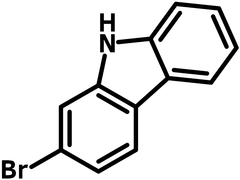2-Bromo-9H-carbazole
CAS Number 3652-90-2
Chemistry Building Blocks, Heterocyclic Building Blocks, Materials, MonomersA convenient intermediate for construction of more complex structures
Used in application of organic photovoltaic and OLED devices.
Specifications | MSDS | Literature and Reviews
2-Bromo-9H-carbazole (CAS number 3652-90-2) is a mono-brominated derivative of 9H-carbazole at 2-position bearing both bromo and amine functional groups. It has been used for further synthesis of semiconducting small molecules and polymers in application of OLEDs, dye sensitized solar cells, polymer and perovskite solar cells.
PyEtCz, a deep blue fluorescent material derived from 2-Bromo-9H-carbazole, shows good thermal stability exhibits strong deep-blue emission with high fluorescent quantum yield of 75%. Device performance with maximum luminance of 6573 cd m-2 and maximum luminance efficiency of 3.24 cd A-1 (3.35%) was achieved with CIE coordinate of (0.15, 0.10). The molar ratio of the 2-bromo-9H-carbazole phosphor to acrylamide can strongly influences the room-temperature phosphorescent (RTP) emission intensities and quantum yields of the blue–purple phosphorescence emitting amorphous copolymer of 2-bromocarbazole phosphor and acrylamide [1, 2].
Carbazole building block
for the synthesis of OLED and organic photovoltaic materials
Worldwide shipping
Quick and reliable shipping
Substituted with a bromide group
for facile reactions
High purity
>98% Purity
General Information
| CAS Number | 3652-90-2 |
| Chemical Formula | C12H8BrN |
| Full Name | 2-Bromo-9H-carbazole |
| Molecular Weight | 246.1 g/mol |
| Synonyms | 2-Bromocarbazole |
| Classification / Family | Carbazoles, semiconductor synthesis intermediates, Electron donor unit, OLED, OFETs, organic photovoltaics |
Chemical Structure

Product Details
| Purity | >98% (1H NMR) |
| Melting Point | 255 °C |
| Appearance | Off-white to beige powder |
MSDS Documentation
 2-Bromo-9H-carbazole MSDS Sheet
2-Bromo-9H-carbazole MSDS Sheet
Literature and Reviews
- Efficient deep blue emitter based on carbazole-pyrene hybrid for non-doped electroluminescent device, T. Zhang et al., Opt. Mater., 100, 109632 (2020); DOI: 10.1016/j.optmat.2019.109632.
- Amorphous 2-Bromocarbazole Copolymers with Efficient Room-Temperature Phosphorescent Emission and Applications as Encryption Ink, T. Zhang et al.,Ind. Eng. Chem. Res., 56, 11, 3123–3128 (2017); 10.1021/acs.iecr.7b00149.
- Hole-transporting side-chain polystyrenes based on TCTA with tuned glass transition and optimized electronic properties, F. Limberg et al., RSC Adv., 5, 83122-83128 (2015); DOI: 10.1039/C5RA12963J.
